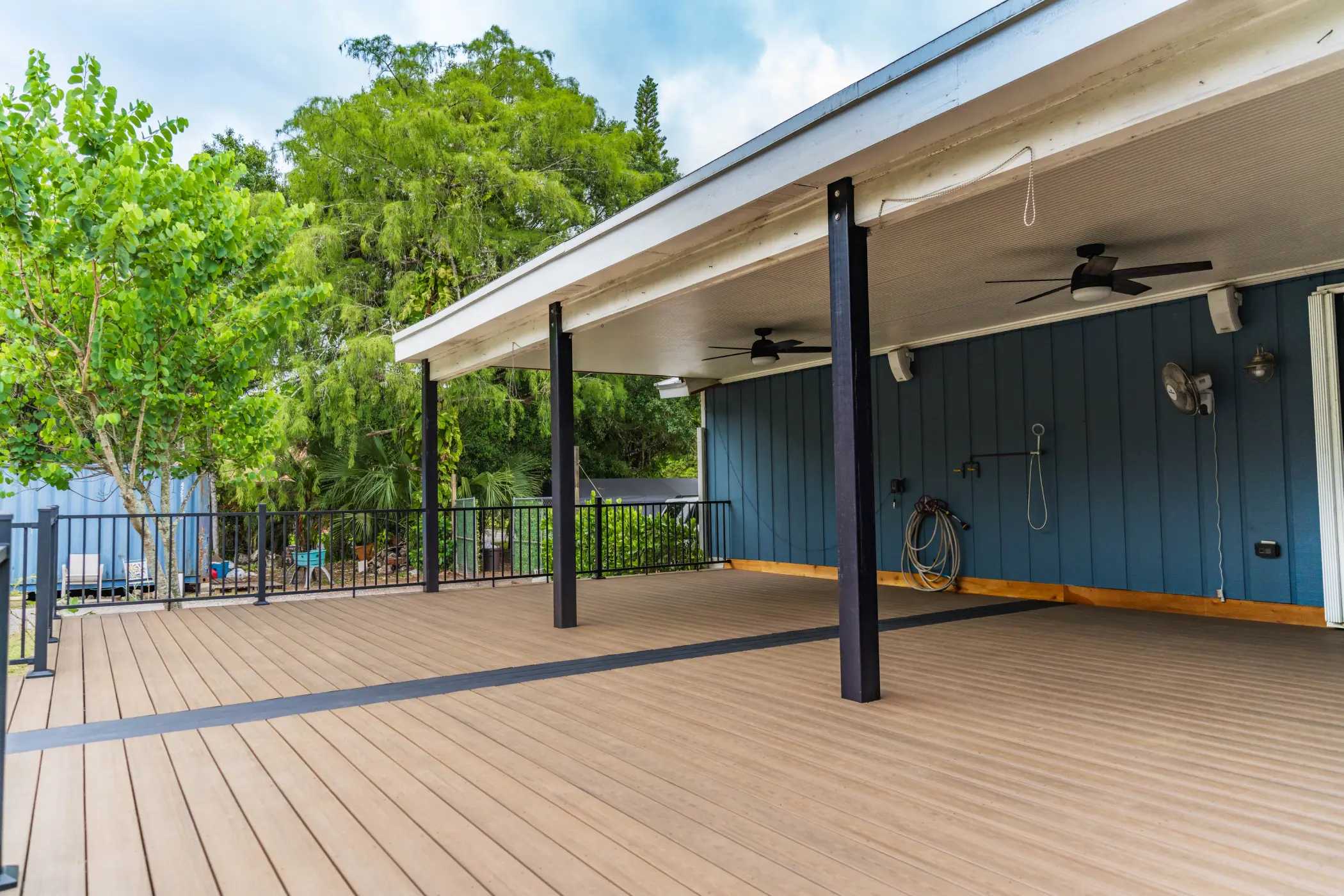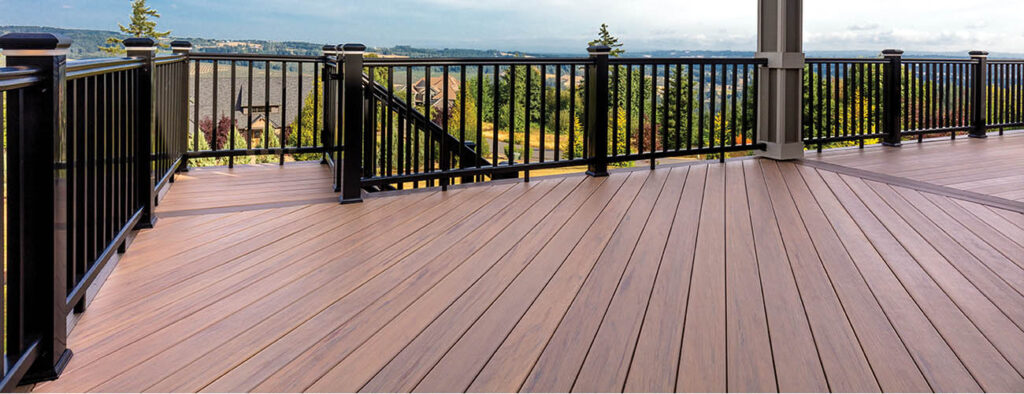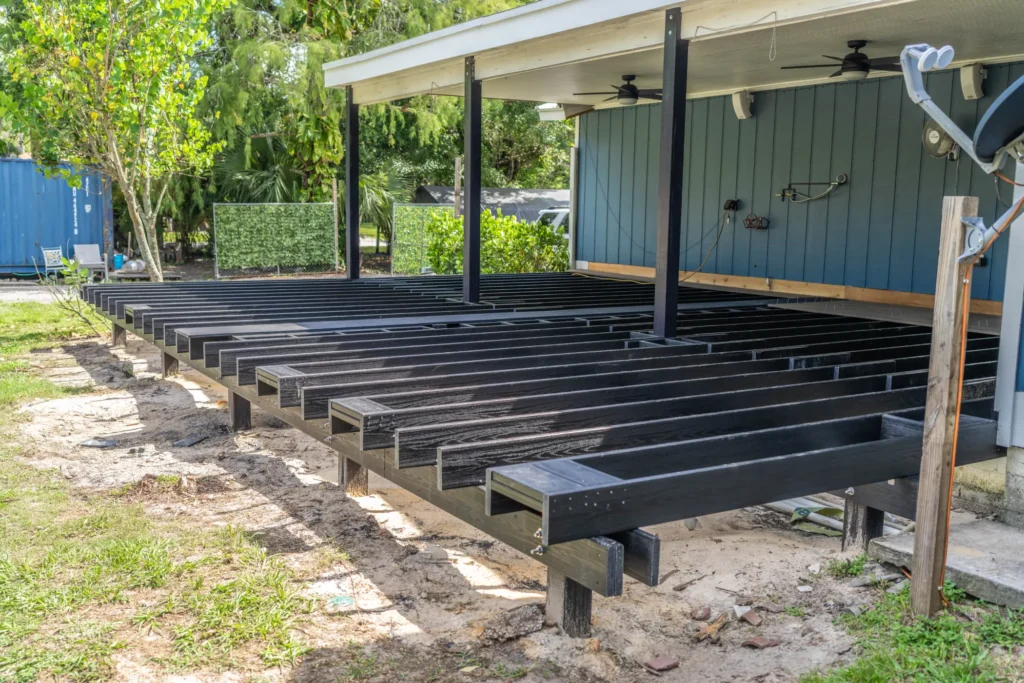
Parallel or Perpendicular: Which Way Should Deck Boards Run?
If you’re building a new deck or resurfacing an old deck, you’ve probably found yourself staring at a pile of deck boards, wondering what direction deck boards should run. It seems like a simple question, but like most things in construction, the answer all depends.
Let’s break it all down—parallel, perpendicular, or even diagonal—so you can choose the direction that makes the most sense for your deck, your home, and the style of your outdoor space.
The Standard Rule: Deck Boards Run Perpendicular to the Joists
Most deck boards are installed in a straight line, perpendicular to the joists. That’s the standard method, and for good reason:
- It ensures structural integrity
- It provides even load distribution
- It requires fewer framing modifications
Since joists typically run perpendicular to the house, the boards usually end up running in a horizontal direction parallel to the house. That’s why you often see deck boards running in the same direction as the siding.
In other words, your deck boards should run parallel to the houses and, perpendicular to the joists.
This setup also makes for easier water drainage and minimizes pooling, which helps extend the life of your decking material. Plus, it tends to be the most efficient use of material, reducing waste and labor time.
What If You Want the Boards to Run the Other Way? Does It Matter?
Maybe you prefer the look of boards running perpendicular to the perimeter of the house. Maybe that direction works better with your traffic flow or furniture layout. Can you run deck boards parallel to the joists?
The short answer: Yes, but it takes extra work.
One solution for having your deck boards run in the opposite direction is to add mini joists or blocking between your existing joists and joist hangers to create a secure nailing surface for the boards. This technique is more labor-intensive, but it allows you to customize the board layout without compromising strength.
Some builders install short pieces of 2x framing between the joists to create perpendicular bracing—a solid base for running boards parallel to the joists on the ridge side. If you do this, follow building codes and spacing guidelines. Also, keep in mind that this could impact the way your deck breathes and drains. Make sure you leave appropriate spacing between boards and joists, and seal any end cuts to prevent moisture infiltration.
What About Diagonal Deck Boards?
Diagonal planks are an excellent middle ground. They add visual interest, can make small decks feel larger, and help tie irregular angles together. Diagonal decking is particularly useful if your deck isn’t a perfect rectangle. It can help minimize awkward angles and lend visual continuity across complex shapes.
Structurally, diagonal boards require closer joist spacing (typically 12″ on center instead of 16″) because the boards span more distance per run. You may also need a bit more material due to the angle cuts and additional waste.
The result, however, is a dynamic horizontal design that can elevate the look of your deck significantly. You can even get creative with herringbone patterns or chevrons if you’re ready to level up with something artsy!

Diagonal decking pattern with TimberTech deck boards.
Should Joists Run Parallel or Perpendicular to the House?
Let’s flip the question around: Should you build your joists in a particular direction based on how you want the boards to run?
It depends on your layout. Most decks attach to the house with a ledger board, and the joists run perpendicular to it, extending away from the house. That’s the norm and is usually the simplest, most stable configuration.
But if you’re building a freestanding deck or have more design freedom, you can plan joist orientation to match your desired board direction. Just remember: changing joist direction changes everything, from footing locations to beam spans. Plan accordingly. Make sure your support structure—posts, beams, and joists—is aligned with your desired aesthetic and functional layout. It’s more complex work upfront, but it ensures the entire structure is cohesive and well-integrated.

A strong deck frame is the foundation for a stable and long-lasting deck.
What If You Got Your Deck Board Direction “Wrong?”
So you read this post and realized your deck boards are running in the “wrong” direction. Now what?
Here’s the good news: there is no single “wrong” way, as long as your deck is structurally sound.
If you’re unhappy with how it looks or functions, you can change the direction, but it may require some elbow grease:
- Remove the boards: Carefully pry them up if they’re face-screwed. If they’re hidden fastened, you may need to access clips from underneath.
- Assess the joists: If your new direction doesn’t line up with the joists, you’ll need to add blocking or mini joists to ensure a secure fit.
- Reinstall decking: Lay out the new pattern, fasten according to code, and seal any cuts or ends.
Is it worth it? That depends on your budget, time, and how much the direction bothers you. For many, it’s easier to live with the current layout until it’s time for a full resurface or new decking.
Extra Tips for Smarter Decking: Pick Direction With Intention
- Drainage: Board direction can influence how water sheds off your deck. Boards that slope slightly away from the house and run parallel can help prevent moisture buildup near the home.
- Ventilation: Good airflow under the deck extends the lifespan of the substructure. The board direction can play a small role here, especially in tightly spaced decks.
- Board Lengths: If your deck is longer in one direction, running boards the long way can reduce joints and seams, giving you a cleaner look.
- Furniture & Traffic Flow: Think about how people will move across the space. Boards aligned with walkways or seating areas can make movement feel more natural.
Curved Decking Design Ideas
Unlike traditional or pressure-treated wood, composite decking opens up the option for curved board layouts. Heated and bent to shape, curved boards can follow the contours of a round or serpentine deck design. You can even use accent pieces to accentuate curved lines or delineate different areas of your deck or porch for contrast and separation. You can get creative with composite decking in ways you can’t with a concrete slab!
If you’re going this route, joist framing needs to be meticulously planned and possibly doubled up in areas to provide enough fastening surface.
Need Help Designing or Resurfacing Your Deck?
If you’re still scratching your head over joist orientation or deck board layout, Decks & Docks is here to help. From pressure-treated lumber to all your favorite brands in composite decking, we carry top-quality decking materials, hardware, and fasteners—and we know what works in coastal environments.
Give us a call, shop at our online partner, or stop by your local store. We’ll help you figure out the best direction for your deck boards—and everything else, too!
FAQ: Quick Answers on Deck Board Direction
Can I mix board directions in one deck?
Yes, especially in multi-level or zoned decks. Just make sure the framing underneath supports the layout.
Do composite decking boards follow the same rules as conventional lumber?
Yes, they generally follow the same rules as wooden decking boards, though composites may require specific fasteners or gapping depending on manufacturer guidelines.
Is diagonal more expensive?
Usually, yes. You’ll need more boards due to waste and closer joist spacing, but the look may be worth it.
Can I use deck board direction to hide flaws?
Absolutely. Strategic layout can disguise uneven edges, weird angles, or surface irregularities.
- About the Author
- Latest Posts
Dan has worked for Decks and Docks for over twenty-five years. He managed the original Decks and Docks store in St. Pete, which is our largest store. Dan is simply the best all around. He knows more about this company and our products than probably anyone else. Dan currently works in Sales at our corporate office.
